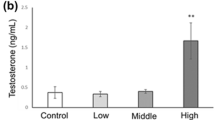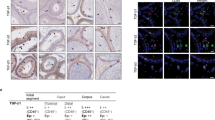Abstract
α2u GLOBULIN is an androgen-dependent rat urinary protein with a molecular weight of about 23,800 (ref. 1). In the male rat, starting from puberty until senescence, α2u globulin is synthesised and secreted by the hepatic tissue and is rapidly cleared by the kidneys into the urine2–4. In addition to its urinary concentration α2u globulin has been found to be concentrated by the salivary glands and released into the saliva (A.K.R., and J.G.B., in preparation). Synthesis of this protein could be induced in the spayed female rat by androgen, and oestrogenic compounds completely inhibited α2u synthesis in the mature male rat5. But α2u globulin does not bind testosterone, oestradiol-17β or any of their metabolites (unpublished results of A.K.R.). Pretreatment of mature male rats with oestrogen induces a dose-dependent temporary lag period within which α2u globulin is not synthesised even under androgenic stimulation. With a daily oestradiol dose of 50 µg per 100g body weight a lag period extending up to 3–4 weeks has been established6. Although the adult male rat synthesises 20–30 mg of α2u globulin per day, no physiological role of this protein has yet been established. The close parallel between the male reproductive capability and the production of α2u globulin4,5 prompted us to look into the possible reproductive role of this protein. The discovery of the oestrogen-mediated lag period in the mature male rats also provided an opportunity to look into the spermatogenic abnormalities within this lag period and any reparative effects which α2u globulin may have on such damage. The results reported here demonstrate considerable protection of spermatogenesis by α2u globulin against potential damage by oestrogen.
This is a preview of subscription content, access via your institution
Access options
Subscribe to this journal
Receive 51 print issues and online access
$199.00 per year
only $3.90 per issue
Buy this article
- Purchase on Springer Link
- Instant access to full article PDF
Prices may be subject to local taxes which are calculated during checkout
Similar content being viewed by others
References
Roy, A. K., Neuhaus, O. W., and Harmison, C. R., Biochim. biophys. Acta, 127, 72–81 (1966).
Roy, A. K., and Neuhaus, O. W., Biochim. biophys. Acta, 127, 82–87 (1966).
Roy, A. K., and Raber, D. L., J. Histochem. Cytochem., 20, 89–96 (1972).
Roy, A. K., Milin, B. S., and McMinn, D. M., Biochim. biophys. Acta, 354, 213–232 (1974).
Roy, A. K., and Neuhaus, O. W., Nature, 214, 618–620 (1967).
Roy, A. K., McMinn, D. M., and Biswas, N. M., Endocrinology, 97, 1501–1508 (1975).
Roy, A. K., J. Endocr., 56, 295–301 (1973).
Lacy, D., and Lofts, B., Proc. R. Soc., 162, 188–197 (1965).
Goodman, M., Hum. Biol., 34, 104–150 (1962).
Midgley, A. R., Jr., J. clin. Endocr. Metabolism, 27, 295–299 (1967).
Leblond, C. P., and Clermont, Y., Ann. N. Y. Acad. Sci., 55, 548–573 (1952).
Perey, B., Clermont, Y., and Leblond, C. P., J. Anat., 108, 47–77 (1961).
Author information
Authors and Affiliations
Rights and permissions
About this article
Cite this article
ROY, A., BYRD, J., BISWAS, N. et al. Protection of spermatogenesis by α2u globulin in rats treated with oestrogen. Nature 260, 719–721 (1976). https://doi.org/10.1038/260719a0
Received:
Accepted:
Issue Date:
DOI: https://doi.org/10.1038/260719a0
This article is cited by
Comments
By submitting a comment you agree to abide by our Terms and Community Guidelines. If you find something abusive or that does not comply with our terms or guidelines please flag it as inappropriate.



